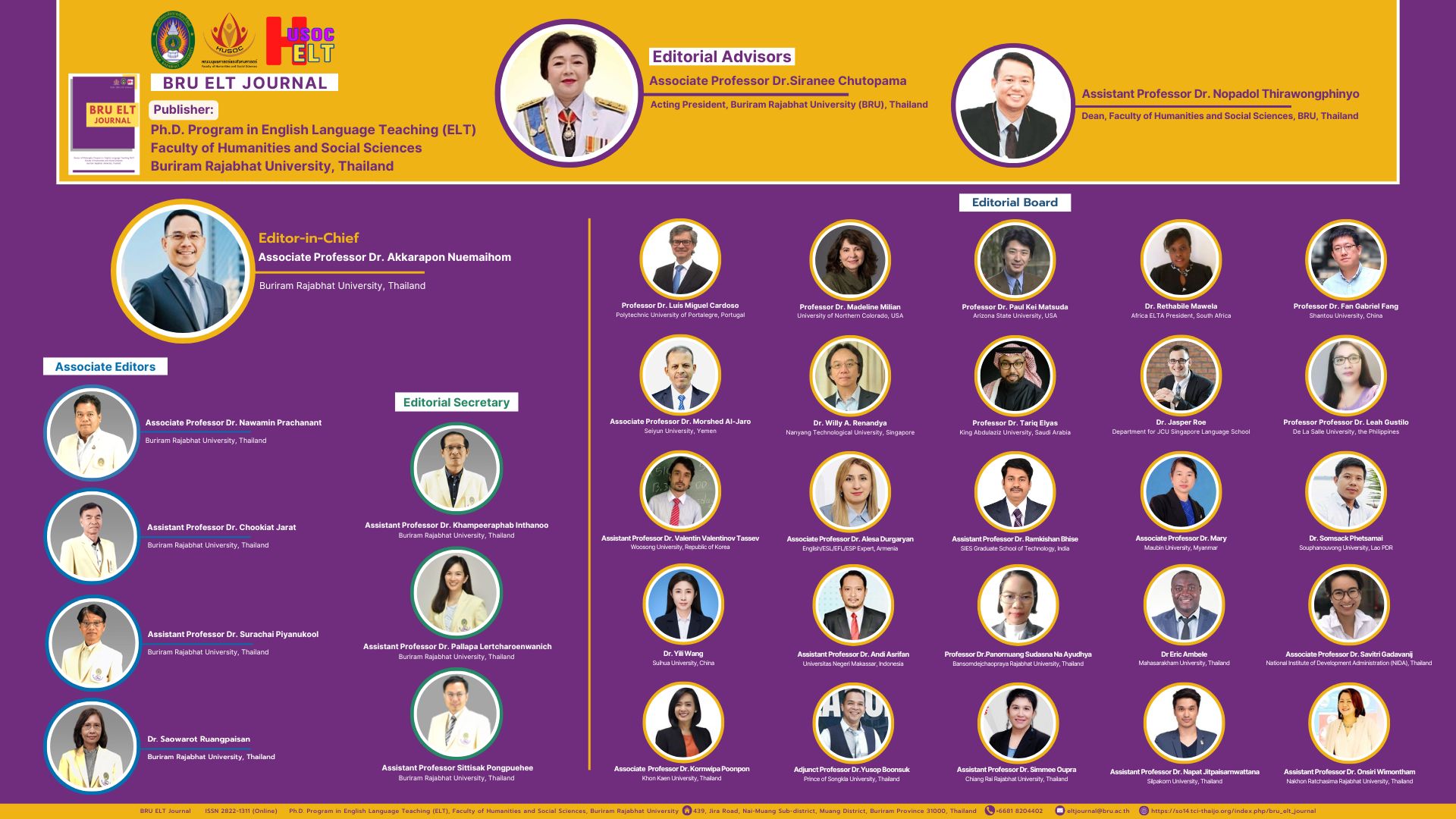Language, Culture and Society in ELT: Perspectives of University Students and Teachers in Myanmar and India
DOI:
https://doi.org/10.14456/bej.2023.18Keywords:
language, culture, society, English language teachingAbstract
In English language classrooms, exploring the interplay of language, culture, and society highlights the vital role of cultural fluency in enabling accurate interpretation of spoken expressions, crafting culturally and socially appropriate statements, and minimizing communication breakdowns for university-level students. The objectives of this research are to investigate how university students in Myanmar and India perceive English language learning and to gauge the perspectives of English language teachers regarding the importance of cultural background knowledge in language teaching. The questionnaire, distributed to language classes in selected universities in Myanmar and India, yielded responses from 124 students in Myanmar and 151 students in India out of the 300 questionnaires sent out, while the interview survey, conducted through convenience sampling, involved 44 teachers from Myanmar and 51 teachers from India. Quantitative data analysis is conducted using statistics such as percentages, means, and standard deviations. The findings reveal that cultural fluency, signifying a deep understanding of culture and society, plays a pivotal role in enhancing language learners’ comprehension and proficiency in the target language. This study implies that its findings contribute to boosting language learners’ communication skills and self-confidence, essential attributes for navigating various societal, travel, and occupational situations with practical relevance.
References
Adaskou, K., Britten, D., & Fahsi, B. (1990). Design decisions on the cultural content of a secondary English course for Mororcco. ELT journal, 44(1), 3-10.
Cole, M., & Scribner, S. (1974). Culture & thought: A psychological introduction. John Wiley & Sons.
Diaz, C. F. (2001). The third millennium, a multicultural imperative for education. Multicultural education in the 21st century, 1-10.
Emitt, M. P. J., & Komesaroff, L. (2003). Language and learning. Oxford University Press.
Fasold, R. W. (1990). The sociolinguistics of language (Vol. 2). Blackwell Pub.
Garcia, E. (2002). Student cultural diversity: Understanding and meeting the challenge (3rd ed.). Houghton Mifflin.
Goodenough, W. H. (1957). Cultural anthropology and linguistics. Bobbs-Merrill.
Hayati, A. M. (2009). The impact of cultural knowledge on listening comprehension of EFL learners. English Language Teaching, 2(3), 144–151.
Hess, D. T., Matsumoto, A., Kim, S. O., Marshall, H. E., & Stamler, J. S. (2005). Protein S-nitrosylation: purview and parameters. Nature Reviews Molecular Cell Biology, 6(2), 150-166.
Hoebel, E. A., & Frost, E. L. (1976). Cultural and social anthropology. McGraw-Hill.
Holmes, J. (2013). An introduction to sociolinguistics (4th ed.). Pearson.
Jourdan, C., & Tuite, K. (Eds.). (2006). Language, culture, and society: Key topics in linguistic anthropology (Vol. 23). Cambridge University Press.
Kachru, B. B. (Ed.). (1992). The other tongue: English across cultures. University of Illinois Press.
Lee, H. L. J. (2016). Code switching in the teaching of English as a second language to secondary school students. Malaysian Journal of ELT Research, 6(1), 45.
Lustig, M. W., & Koester, J. (2010). Intercultural competence: Interpersonal communication across cultures (6th ed.). Pearson.
McGroarty, M. (1993). Cross-cultural issues in adult ESL literacy classrooms. ERIC Clearinghouse.
McKay, S. (2003). Teaching English as an international language: The Chilean context. ELT Journal, 57(2), 139-148.
Namaziandost, E., Sabzevari, A., & Hashemifardnia, A. (2018). The effect of cultural materials on listening comprehension among Iranian upper-intermediate EFL learners: In reference to gender. Cogent Education, 5(1), 1560601.
Rallis, S., & Casey, C. (2005). Language and cultural diversity in U.S. schools. Praeger.
Roebl, K., Shiue, C., & Bragg, N. P. (2016). Language, culture and society: implication in EFL teaching.
Samovar, L. A., Porter, R.E., & Jain, N. C. (1981). Understanding intercultural communication. Wadsworth Publishing Company.
Walker, M. (2005). Quaternary dating methods. John Wiley and Sons.
Wang, J. (2011). Culture differences and English teaching. English Language Teaching, 4(2), 22-230. DOI:10.5539/elt.v4n2p223
Wardhaugh, R., & Fuller, J. M. (2021). An introduction to sociolinguistics. John Wiley & Sons.






